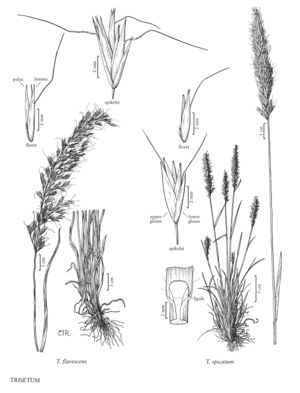Trisetum spicatum
Plants perennial, with both fertile and sterile shoots; cespitose, not rhizomatous. Culms 10-120 cm, clumped, erect, usually glabrous, sometimes villous, sometimes scabridulous. Leaves mostly basal or evenly distributed; sheaths variously pubescent or glabrous; ligules 0.5-4 mm, truncate or rounded; blades (3) 10-20 (40) cm long, 1-5 mm wide, flat, folded, or involute, erect and stiff or ascending and lax. Panicles (5) 20-30 (50) cm long, (0.5) 1-2.5 (5) cm wide, spikelike to open, often interrupted basally, green, purplish, or tawny, usually silvery-shiny; branches with the spikelets evenly distributed. Spikelets 5-7.5 mm, sessile, subsessile, or on pedicels to 1.5 (3.5) mm, with 2 (3) florets; rachilla internodes 0.5-1.5 mm; rachilla hairs to 1 mm. Glumes subequal to unequal, lanceolate, usually smooth, sometimes sparsely scabrous, sometimes pilose, with wide scarious margins, apices acute to acuminate, sometimes apiculate; lower glumes 3-4 (5.5) mm; upper glumes 4-7 mm long, as long as or longer than the lowest florets, less than twice as wide as the lower glumes; callus hairs to 1 mm; lemmas 3-6 (7) mm, narrowly to broadly lanceolate, glabrous or pilose, sometimes scabridulous, apices bifid, teeth usually shorter than 1 mm, awned, awns 3-8 mm, arising from the upper 1/3 of the lemmas and exceeding the apices, geniculate, twisted basally; anthers 0.7-1.4 mm. Caryopses 1.5-3 (4) mm, glabrous. 2n = 14, 28, 42.
Distribution
Conn., Mass., Maine, N.H., Vt., Wash., Wis., Wyo., N.Mex., N.C., Alta., B.C., Greenland, Man., N.B., Nfld. and Labr., N.S., N.W.T., Nunavut, Ont., Que., Sask., Yukon, Tenn., N.Y., Pa., R.I., Nev., Va., Colo., Alaska, Ariz., Calif., Idaho, Utah, Minn., Mich., Mont., Oreg., S.Dak.
Discussion
Trisetum spicatum grows in moist meadows and forests, and on rock ledges, tundra slopes, and screes, at 0^1300 m. Its range includes both North and South America and Eurasia. Many infraspecific taxa have been based on the variation in vestiture and openness of the panicle, but none appears to be justified (see Finot et al. 2004 for a different opinion). Trisetum montanum Vasey appears to represent no more than an extreme phase. Trisetum spicatum differs from T. sibiricum in its pubescent sheaths and denser, usually narrower panicles.
Selected References
None.
Lower Taxa
"decumbent" is not a number.
